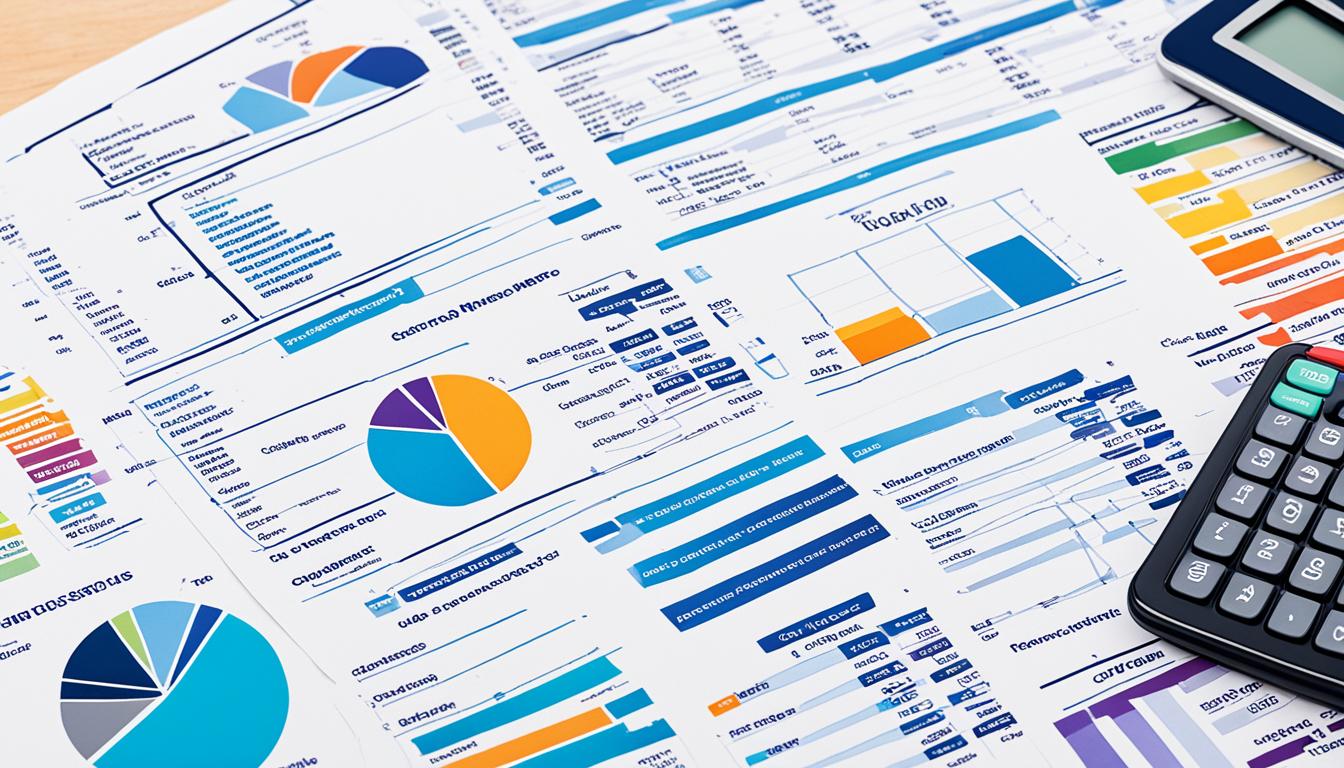Did you know that small businesses in the United States spend an average of over $30,000 annually on operating expenses alone? With the myriad of costs involved in running a business, it’s essential for entrepreneurs and business owners to gain a comprehensive understanding of their financial outlays to ensure long-term success.
From calculating startup expenses to analyzing business expenditures, managing costs is a crucial aspect of maintaining financial sustainability. In this article, we will delve into the various factors that contribute to business running costs in the US, offering insights and strategies to help you optimize your expenses and improve your company’s bottom line.
Key Takeaways:
- Businesses in the US spend on average over $30,000 annually on operating expenses.
- Understanding and managing business running costs is essential for financial sustainability.
- Analyzing startup costs and implementing cost-saving strategies can help optimize expenses.
- Managing labor costs, including wages and benefits, is crucial for financial planning.
- Regular evaluation and adjustment of cost structures are necessary to remain competitive and successful.
Categories of Business Expenses
Business expenses can be categorized into three main categories: direct expenses, indirect expenses, and interest on debt. Understanding these categories is essential for proper financial management and maximizing deductions.
Direct Expenses
Direct expenses are costs directly associated with the production of goods or services. These expenses are directly attributable to the creation of the products or services a business offers. Examples of direct expenses include:
- Direct labor costs
- Factory overhead
- Costs of raw materials
By deducting these direct expenses, businesses can accurately calculate their cost of goods sold (COGS) and determine their gross profit.
Indirect Expenses
Indirect expenses, also known as overhead expenses, are not directly tied to the production process but are necessary for the overall operation of the business. These expenses support the day-to-day functioning and management of the company. Examples of indirect expenses include:
- Executive compensation
- General expenses
- Depreciation
- Marketing costs
Indirect expenses are deducted separately from the gross profit to calculate the operating profit.
Interest on Debt
Interest on debt is another category of business expenses. When a business takes on debt, such as loans or credit lines, the interest paid on that debt is considered an expense. This expense is deducted from the gross profit to determine the operating profit. It is essential for businesses to factor in interest expenses when assessing their profitability and financial performance.
Understanding the different categories of business expenses allows businesses to track and manage their expenses more effectively. By properly categorizing expenses, businesses can ensure accurate financial reporting, maximize deductible business expenses, and make informed financial decisions.
Startup Costs for New Businesses
Starting a new business involves various expenses that are crucial to consider in the planning process. Understanding the startup costs and properly budgeting for them is essential for the success and financial sustainability of your business. In this section, we will explore the key elements of startup costs and how they contribute to the establishment of a new business.
Initial Investment and Business Plan
One of the primary components of startup costs is the initial investment required to launch your business. This includes expenses such as acquiring licenses and permits, setting up a physical location or website, and purchasing equipment and inventory. It is important to create a comprehensive business plan that outlines your financial projections and estimates the costs associated with these initial investments.
“A well-developed business plan is not only crucial for attracting investors and securing financing but also for accurately estimating the startup costs and ensuring you have a solid financial foundation for your business.”
Research and Development Expenses
Conducting market research, studying industry trends, and analyzing competition are vital steps in starting a new business. Research and development expenses include costs associated with feasibility studies, customer surveys, product testing, and prototype development. Properly allocating funds for research and development will enable you to make informed decisions and position your business competitively in the market.
Borrowing Costs and Insurance Fees
Many new businesses rely on external financing to cover their startup costs. Borrowing costs include interest payments on loans, fees for loan application and processing, and any associated legal expenses. Additionally, insurance fees must be factored into your startup budget to protect your business and its assets from unforeseen events or liabilities.
Technology and Equipment Acquisition
In today’s digital age, technology plays a crucial role in the success of many businesses. Acquiring the necessary technology, hardware, and software is a significant expense that should be accounted for in your startup costs. Whether it is investing in point-of-sale systems, office equipment, or cloud computing services, allocating funds for technology and equipment is essential to ensure smooth operations.
Startup Costs Breakdown
| Expense Category | Cost Examples |
|---|---|
| Initial Investment | License fees, equipment purchase, website development |
| Research and Development | Market research, prototype development, feasibility studies |
| Borrowing Costs | Interest payments, loan application fees, legal expenses |
| Insurance Fees | General liability insurance, property insurance |
| Technology and Equipment | Computers, software, office equipment |
Properly estimating and planning for these startup costs will help you navigate the initial stages of your business and ensure that you have the necessary resources to launch and operate effectively.

Strategies for Reducing Labor Costs
Labor costs can have a significant impact on a business’s overall expenses. To optimize financial sustainability, it’s crucial for businesses to find ways to reduce labor expenses. Here are some effective strategies:
Cutting Back on Overtime
Overtime can quickly escalate labor costs. By carefully monitoring and managing overtime hours, businesses can minimize excessive expenses. Encourage employees to complete their tasks within regular working hours and provide clear guidelines for overtime approval.
Offering Incentives
Providing incentives for employees to work their allotted hours can help control labor costs. Rewarding punctuality and adherence to schedules can motivate employees to be productive during their regular work hours, reducing the need for overtime.
Careful Hiring Practices
High turnover rates can lead to increased labor costs due to recruitment, training, and onboarding expenses. Implementing a careful hiring process that focuses on finding the right candidate fit can help reduce turnover and associated costs.
Utilizing Temporary Labor
During peak periods or when demand fluctuates, using temporary labor can be a cost-effective solution. Temp labor allows businesses to flexibly adjust their workforce without incurring long-term employment costs.
Implementing these strategies can help businesses optimize labor costs, reduce expenses, and improve overall financial efficiency and sustainability.

Labor Cost Optimization Strategies
| Strategy | Key Benefits |
|---|---|
| Cutting back on overtime | – Minimizes excessive labor expenses – Improves work-life balance for employees |
| Offering incentives | – Motivates employees to adhere to regular working hours – Reduces the need for costly overtime |
| Careful hiring practices | – Reduces turnover costs – Enhances employee retention |
| Utilizing temporary labor | – Provides flexibility in managing workforce – Reduces long-term employment costs |
Salary Budgets and Benefits Costs
When it comes to managing labor expenses, salary budgets and benefits costs play a significant role. These factors are influenced by various economic and organizational considerations, ultimately impacting a company’s financial viability and ability to attract and retain top talent. Let’s explore how companies navigate these aspects and optimize their allocation of resources.
Inflation and Salary Budgets
Inflation is a crucial factor to consider when formulating salary budgets. As the cost of living increases, companies must adjust their compensation plans to ensure employees’ purchasing power is maintained. With an average projected inflation rate of 2.3% in 2023, employers must account for this rise in their salary budgets to keep up with market trends and stay competitive.
Competitiveness and Attracting Talent
Attracting high-quality talent is a priority for any organization, and offering competitive salaries is one of the primary ways to achieve this. By benchmarking industry standards and competitor compensation packages, businesses can align their salary budgets with market expectations, ensuring they remain an attractive option for top candidates. This strategic approach helps secure the right talent and reduces the risk of losing potential employees to competitors.
Benefits Costs and Financial Planning
In addition to salaries, employers must account for the rising costs of employee benefits when managing labor expenses. Benefits costs, which include healthcare coverage, retirement plans, and other perks, are continually increasing. In fact, employers experienced an average benefits cost increase of 6.5% per employee in 2023. Proactive financial planning and allocation of resources are essential to effectively manage benefits costs while maintaining an attractive benefits package for employees.
Optimizing Resource Allocation: HR and Finance Collaboration
To successfully manage salary budgets and benefits costs, collaboration between HR and finance teams is crucial. These cross-functional partnerships enable the alignment of financial goals with talent acquisition strategies. HR teams provide invaluable insights into compensation trends and candidate expectations, while finance teams offer expertise in budgeting, forecasting, and cost analysis. By leveraging their collective knowledge, organizations can optimize resource allocation and drive financial sustainability.
| Year | Projected Salary Increase | Benefits Cost Increase per Employee |
|---|---|---|
| 2023 | 4.1% | 6.5% |
Understanding Total Labor Costs
Total labor costs are a crucial component of a business’s overall expenses. These costs encompass various elements, including employee salaries, benefits, payroll taxes, and additional expenses. By understanding and managing these costs effectively, businesses can make informed decisions and ensure financial stability.
Direct Costs:
Direct costs are directly tied to the production of goods or services. They include wages paid to employees involved in manufacturing, production materials, and any other expenses directly incurred in the creation of the product or service. Examples of direct costs include direct labor costs and costs of raw materials.
Indirect Costs:
Indirect costs, on the other hand, are not directly associated with production. These costs support the overall operation of the business. Common examples of indirect costs include executive compensation, general expenses, marketing costs, and depreciation of assets.
Variable Costs:
Variable costs are costs that can change depending on certain factors. For labor costs, these could include production output levels or the need for overtime hours. By analyzing variable costs, businesses can identify areas where adjustments can be made to optimize expenses and improve productivity.
Calculating the labor cost percentage is a valuable tool for assessing cost structures. It allows businesses to measure the proportion of labor costs in relation to other expenses, providing insights into the overall financial health of the organization. By understanding the different types of labor costs and their impact on the budget, businesses can make strategic decisions to maximize profitability and financial efficiency.
| Expense Category | Description |
|---|---|
| Employee Salaries | Wages paid to employees for their work |
| Employee Benefits | Additional perks and benefits provided to employees |
| Payroll Taxes | Taxes withheld from employee wages and paid by the employer |
| Additional Expenses | Other costs associated with labor, such as training or uniforms |
Conclusion
Understanding and effectively managing business running costs is crucial for achieving financial sustainability. By carefully categorizing expenses, accurately estimating startup costs, implementing strategies to reduce labor costs, and closely monitoring salary budgets and benefits costs, businesses can optimize their expenses and improve their overall financial performance.
By categorizing expenses into direct and indirect costs, businesses can gain a better understanding of where their money is being spent and identify areas for potential cost savings. Accurately estimating startup costs is vital for planning and budgeting effectively from the beginning, ensuring that resources are allocated appropriately.
Implementing strategies to reduce labor costs, such as cutting back on overtime, offering incentives, and utilizing temporary labor, can help to optimize expenses while maintaining productivity. Additionally, closely monitoring and managing salary budgets and benefits costs can help businesses control labor expenses and adapt to changing market conditions.
To remain competitive and successful, businesses must continuously evaluate and adjust their cost structures. Regularly reviewing and optimizing business running costs is crucial for maintaining financial sustainability, improving profitability, and ensuring long-term success in today’s dynamic business environment.
FAQ
What are business operating expenses?
Business operating expenses are costs incurred in the ordinary course of business, such as advertising expenses, wages, insurance costs, and utility expenses. These expenses are subtracted from revenue to determine taxable net income.
What are the categories of business expenses?
Business expenses can be categorized as deductible business expenses, which include direct expenses (e.g., cost of goods sold) and indirect expenses (e.g., executive compensation, marketing costs). Interest on debt is also considered an expense.
What are startup costs for new businesses?
Startup costs are the expenses incurred during the process of creating a new business. They can include costs for creating a business plan, conducting research, borrowing capital, obtaining insurance, and acquiring necessary technology and equipment.
What are some strategies for reducing labor costs?
Businesses can reduce labor costs by cutting back on overtime, offering incentives for employees to work their allotted hours, carefully hiring the right candidates to reduce turnover costs, and using temporary labor during peak times.
How do salary budgets and benefits costs impact businesses?
Salary budgets are influenced by factors such as inflation and the costs of employee benefits. On average, companies are planning to increase pay by 4.1% in 2023. Employers’ costs for benefits are also rising, with an average increase of 6.5% per employee in 2023.
What are total labor costs and their components?
Total labor costs include employee salaries, benefits, payroll taxes, and additional expenses. Direct costs are tied to the production of goods or services, while indirect costs are not directly associated with production. Variable costs can change depending on factors such as production output or overtime hours.
How can businesses optimize their expenses and achieve financial sustainability?
Understanding and managing business running costs is essential. By categorizing expenses, estimating startup costs accurately, implementing strategies to reduce labor costs, and monitoring salary budgets and benefits costs, businesses can optimize their expenses and improve overall financial performance.


